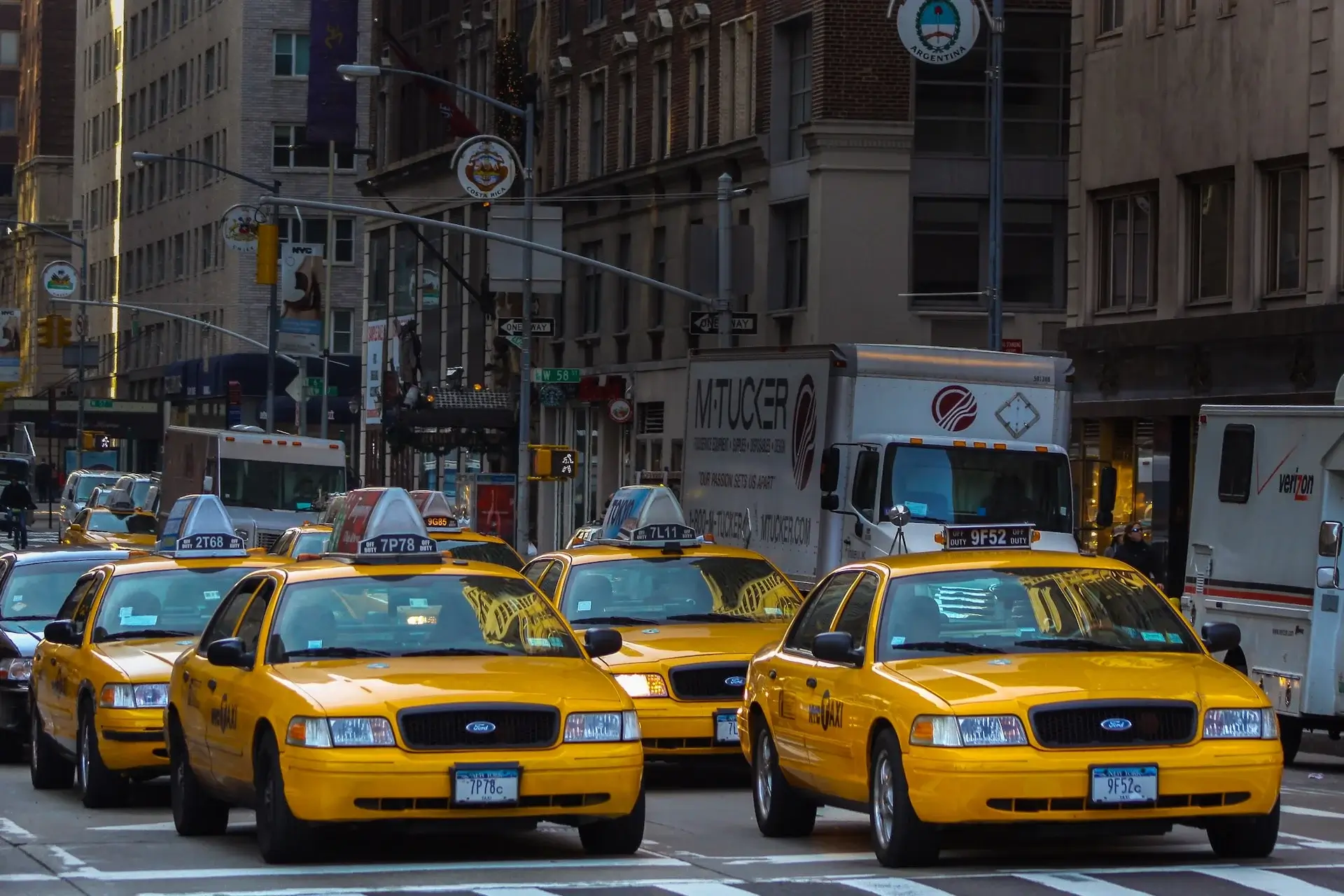How to build an app like Uber? What are the key features and nuances? How to monetize such an application? Finally, how to find the right taxi app development company? If you’re asking any of these questions, you’ve come to the right place. In this detailed article, we will explain in detail how to make a taxi app with ease – we will describe how Uber works, analyze its architecture, describe the key features and tech stack, and calculate the minimal budget and timeline needed to build an app like Uber.
More and more people in the startup world are wondering how to make an app like Uber and if taxi booking app development is a good business idea. As the demand for services like Uber grows, there appear new competitors in the market. However, you should bear in mind that even though there are high demand and many opportunities in that niche, a taxi application is not the easiest one to build. It is a complex application (or rather a group of interconnected applications) with many features and vast functionality.
The good news is that once you understand the basic architecture and principles, the rest of the design and development process becomes much easier. Seeing so many regular Google search queries like “how to develop an app like Uber”, “create an app like Uber”, and a million others, we decided to write a long and detailed analysis to answer all of these questions. But first, let’s remind ourselves what Uber is and how it works.
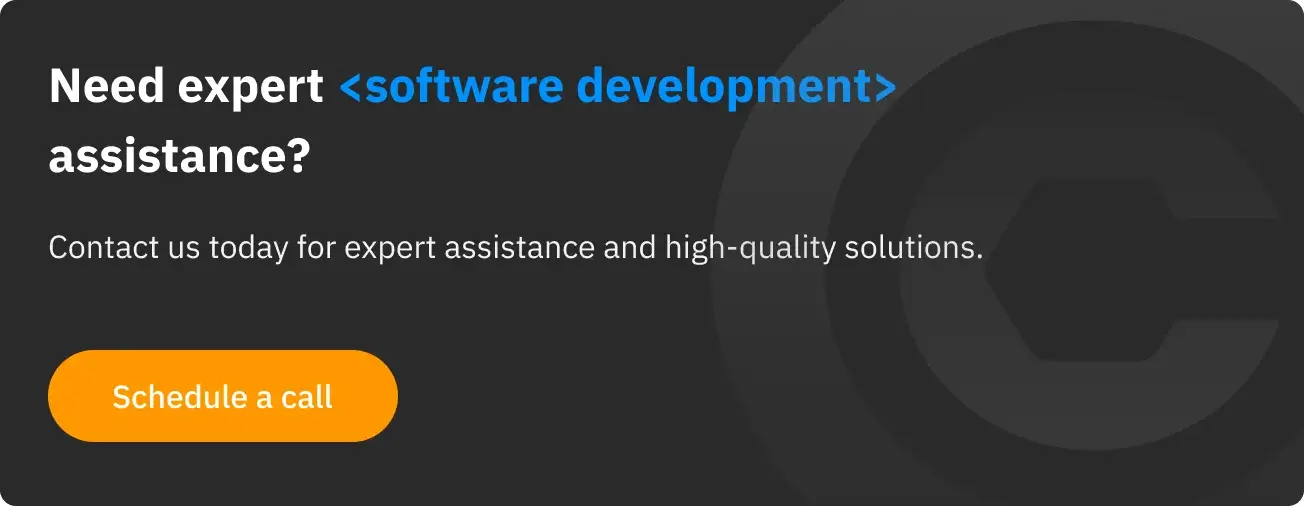
Taxi Application Development - Uber’s Example
Started over 10 years ago by Garrett Camp and Travis Kalanick, Uber is the most popular taxi application at the moment, serving over 200 cities in 67 countries as of today. The two founders started a real revolution in the sharing economy and the taxi world, in particular.
Since then many startups followed the example of Uber in multiple other industries, utilizing the principles of sharing economy. As consumers switched to Uber, many players in the tech world saw opportunities in that niche and introduced competitor apps. This is clearly visible at the national level – in many countries there appear local clones of Uber.
How Uber Works
Uber allows anyone to order a drive to a needed destination. As of now, Uber offers 13 riding services, in addition to Uber Eats, and a few other types of services. The most popular services are:
- UberX. The most popular option – affordable rides for everyone (1-4 passengers).
- Select. A more expensive option which offers premium rides in high-end cars (1-4 passengers).
- Black. Luxury rides with professional drivers.
- UberPool. Lets you share rides with other people who are heading in the same direction.
- Lux. The most luxurious option for premium rides.
- XL. Affordable rides in vans and SUVs (groups of up to 6 people).
Whichever option you pick, the booking process is pretty much the same:
- Pick your destination. First, a user enters his or her location (or GPS finds his or her location automatically) and enters a destination, either by typing it or pinning it on the map.
- Matching. Uber finds drivers nearby and sends requests to them. Once a driver accepts a request, he or she drives to pick you up.
- Arrival. Once an order is confirmed, you receive detailed info about the driver, his or her car. You can see the car’s location on the map as it’s arriving. You can also message or call the driver.
- Ride. The driver picks you up and takes you to your destination.
- Payment. Once you arrive, you must pay either in cash or via a credit card.
- Rating. Once your trip is complete, Uber asks you to rate the driver. You can also tip the driver (if you’re paying with a credit card).
Even though the process seems simple on the outside, it requires complex application architecture to make it work.
Uber Application Architecture
If you think that Uber is just one app, you are mistaken. In reality, Uber is a group of three interconnected apps:
- Passenger app. Application for passengers (iOS and Android) which includes the most features and connects to the backend application via API.
- Driver app. Application for drivers (iOS and Android) which connects to the backend application just like the passenger app.
- Backend admin app. The most important application which processes all data and requests from the passenger and driver apps. It requires an API for both apps as well as adapters for payments, database, etc. It is also worth mentioning that the backend application should connect with the fronted web app.
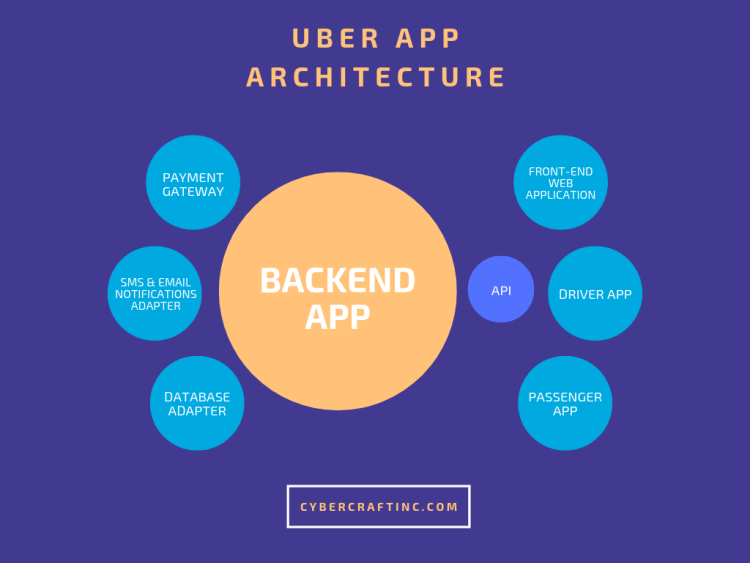
Once you know how Uber works, the next logical question is…
How Uber Makes Money

Uber makes money by taking a portion of drivers’ earnings as well as charging users fees such as the booking and safety fees. The cost of a ride can vary depending on the demand, and other factors. That model has proven profitable and successful. A new competitor can apply the same model or modify it to make it more effective.
Having analyzed how Uber works, let’s talk about the key features your future taxi application should have.
How to Create an App Like Uber: Key Features for the Passenger App
We’re going to discuss the must-have features for both the passenger and driver apps. As we’ve already mentioned the passenger application is a more complex one and requires more features than the driver one:
- Geolocation & map integration
- Registration & login
- Payments
- Booking
- Messaging
- Price calculation
- Safety
- Favorite destinations
- Ratings
- Push notifications
- Drive tracking
- Ride scheduling
- Booking a ride for others
- Fare splitting

Let’s analyze each of these features in detail.
Geolocation & Map Integration

The most essential feature for any taxi application is a map and geolocation. It is necessary to integrate the right map API. The most popular option is Google Maps API which Uber utilizes. As to geolocation, Google’s Geolocation API is the best option.
However, these two options would only suffice for the Android version. In the case with iOS, CoreLocation framework is the only option for geolocation. As to route planning, you should use MapKit.
Registration & Login
Obviously, you want to let users register and create profiles. The registration process usually requires a phone number, full name, and email. Using a phone number to sign up requires SMS verification. Once registration is complete, a user should fill out his or her profile and add payment information.
The key thing to bear in mind is the importance of simple and easy log-in and registration. You want to make it easy to register and log in. The best way to do that is to require as little information as necessary and allow them to log in and sign up via third-party apps such as Facebook
Booking
By “booking” we mean the process and interface which allow a user to enter the location and destination, see the fare estimate and confirm the order. This feature works in conjunction with the price calculator.
Price Calculation

This feature requires an algorithm for correctly estimating fares. The factors which should be taken into the calculation are the distance, demand, etc. Bear in mind that each Uber option has a different formula and pricing. Uber Lux and Uber X have different basic variables used in the calculation.
The formula itself is simple with only three variables. The first variable (or rather a constant) is the basic fee for every mile or kilometer. The second parameter is the demand ratio which correspondingly varies. The product of these two variables is multiplied by the number of miles from the pickup location to the end destination.
Messaging

Passengers can message and call the driver once the latter accepts their drive request. Messaging takes place inside the app. That would require building a messaging solution from scratch or adapt an already existing one such as SendBird, Contus or MirrorFly.
Security
Security is another important aspect of Uber’s functionality. There is a special panic button in Uber’s interface which users can press if they feel in danger. This sends an instant message to the nearest police department, Uber’s administration and the user’s family. It is necessary to implement the highest possible level of security for your future app’s users similarly to how Uber strives to do so.
Favorite Destinations
Users can create lists of favorite destinations which pop-up first whenever they book a fare. They can also name every destination such as home, office, restaurant, etc. This feature makes booking rides to favorite destinations quicker and easier.
Ratings

It is one of the most important features of Uber. Passengers can rate drivers after every ride, and the latter in turn can rate passengers. That feature requires an algorithm which will add up all ratings and calculate the total rating displaying it in a user’s profile. That is a five-point rating system, with five stars (5,0) being the highest possible rating.
Push Notifications
It is impossible to imagine any decent iOS or Android application without push notifications. Notifying passengers when a driver arrives, when a trip is over and so forth is easy with the help of push notifications. This feature is an integral part of any taxi app. For iOS, Apple Push Notification Service is to be used. For Android, Firebase Cloud Messaging. Additionally, you can take things even further by implementing SMS notifications. The most popular services are SNS, Twilio, and Nexmo.
Ride Tracking
Once a ride begins, the app’s interface shows users the current location on the map as they are approaching the destination. It is also necessary to allow a passenger’s relatives to view the passenger’s ride in the same way.
Ride Scheduling
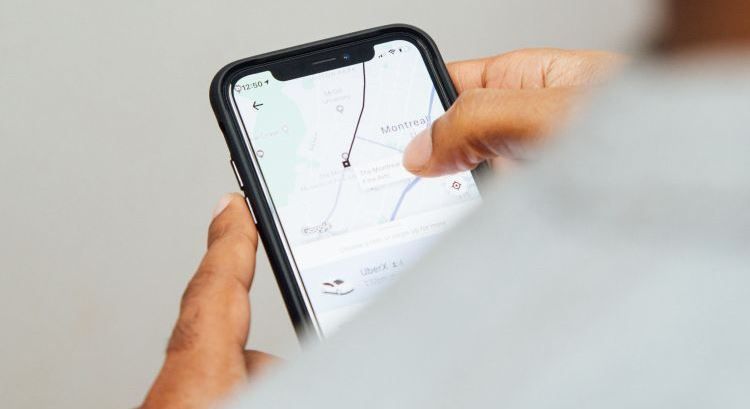
One of the recent features Uber introduced is fare planning which allows users to schedule trips. Implementing fare scheduling would require the use of a calendar and a clock.
Booking a Ride for Others
This feature allows a user to book a ride for friends and relatives (and also schedule trips). Once a booking is confirmed, the person for whom the ride was booked is notified via the application or SMS.
Fare Splitting
This feature allows splitting the cost with other users who are on the same ride. The cost depends on the pickup and drop locations. It is necessary to develop an algorithm to correctly calculate the cost for each passenger.
That algorithm would use the general pricing formula (cost per mile/kilometer * demand ratio * miles) and apply it to every passenger. It would be necessary, therefore, to calculate the distance for every passenger who splits the cost of the fare.
Having talked about the key features of the passenger app, let’s now compare them to the driver’s one.
How to Build an App like Uber: Key Features for the Driver App
Uber drivers enjoy a separate application with a little bit different functionality. It has the following features:
- Registration, Log-in, and Verification
- Driver interface
- Route optimization
- Reporting and analytics
- Preferred destinations
- Heat maps

The driver application has all these features in addition to the ones which both apps share such as price calculation, geolocation, rating, push notifications, messaging, and others. We’re going to analyze each of these driver application features in detail below.
Registration, Log-in & Verification
The registration process is a little bit different for drivers. It includes detailed screening and verification as it should. In particular, drivers need to upload the required documents such as a driver’s license, vehicle registration certificate, and a few others. The car must also meet certain standards for the desired Uber class such as UberX or Black. An old cheap car would not fit for UberLux for sure. Once a driver successfully completes registration & verification, he or she can begin driving.
Driver Interface

The key component of the driver application and taxi app UI design, in general, is the main interface with the map and the necessary functionality for accepting or rejecting rides. Drivers must be given the option to reject a booking or cancel it for free within the first two minutes after accepting.
Route Optimization
This feature requires smart algorithms which can calculate the most optimal route for a driver. It works in conjunction with the maps and GPS. This route optimization algorithm works in conjunction with an estimated time of arrival (ETA).
Estimated Time of Arrival (ETA)
Calculating an approximate time of arrival is an essential feature of both the driver and passenger apps. At the moment, Uber uses its own routing engine, Gurafu, in combination with Flux – Uber’s historical traffic system. However, building a routing calculation system is not enough.
Uber also developed own accuracy tracking tool which constantly monitors the accuracy of its ETA mechanism and provides valuable insights for improving it. Developing an accurate routing engine may prove one of the most voluminous parts of the development process. Luckily, there exist numerous ready-to-use route optimization solutions such as Routific.
Reporting and Analytics

Uber provides weekly and monthly reports for drivers which outline their driving style. If a driver persists in careless driving style, Uber administration may ban him or her. In addition to these reports, the application should provide drivers with detailed analytics of their earnings, past trips, etc.
Preferred Destinations
This feature allows drivers to pick specific directions in which to pick up passengers. It is identical to the favorite destinations feature in the passenger app.
Heat Maps
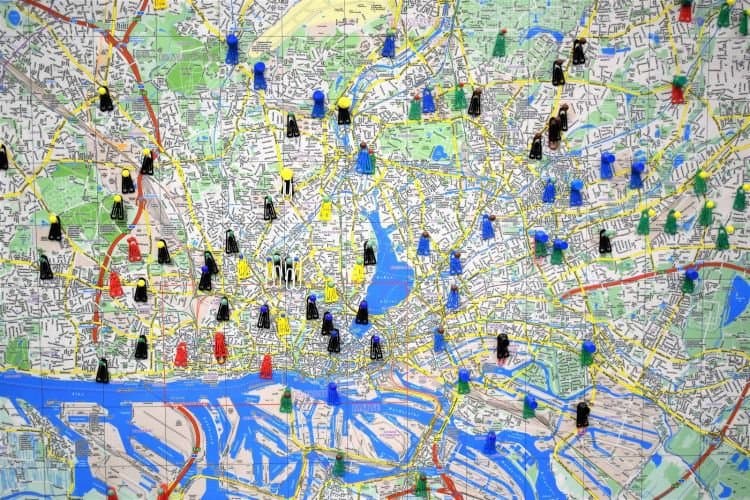
Simply put, a heat map is a map of a current demand. It shows where demand is high and where it’s low. It allows drivers to increase their earnings by moving to high-demand areas which they find with the help of heat maps. Building that feature would require creating a real-time map of bookings by retrieving all the current requests in a certain area and accurately pinning them on the map according to their locations.
Now, let’s talk about the required tech stack to make your own Uber app.
How to Build a Taxi App: The Required Tech Stack
Which exact tech stack your application will have depends on multiple factors. In most cases, the following tech stack would be more or less sufficient:
- Amazon S3
- Amazon EC2
- Google Maps
- Routific
- SNS, Twilio or Nexmo
- SendBird
- Socket.io
- Stripe
- Swift
- Kotlin
- APNS
- Firebase
- CoreLocation
- MapKit
- Node.js
- Objective-C
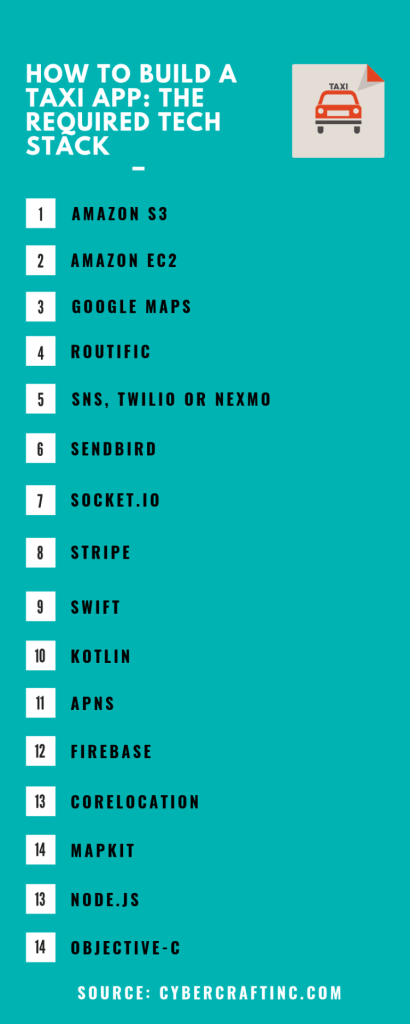
Having analyzed how to build an Uber app, the key features, and the required tech stack, the next logical question is…
How to Monetize a Taxi App?
The revenue model is really simple. Here are the main options you have:
- Commission from drivers’ earnings. Uber and Lyft charge drivers a portion of their earnings. That is the key component of their revenue models.
- Booking fees, service fees, security fees, etc. In addition to commissions, Uber charges passengers a flat booking fee. It’s also possible to add other fees for service, security, etc.
- Cancellation fees. Passengers pay a fee for canceling a ride.
- Advertising. It is also possible to add advertising into your application although it may irritate many users.
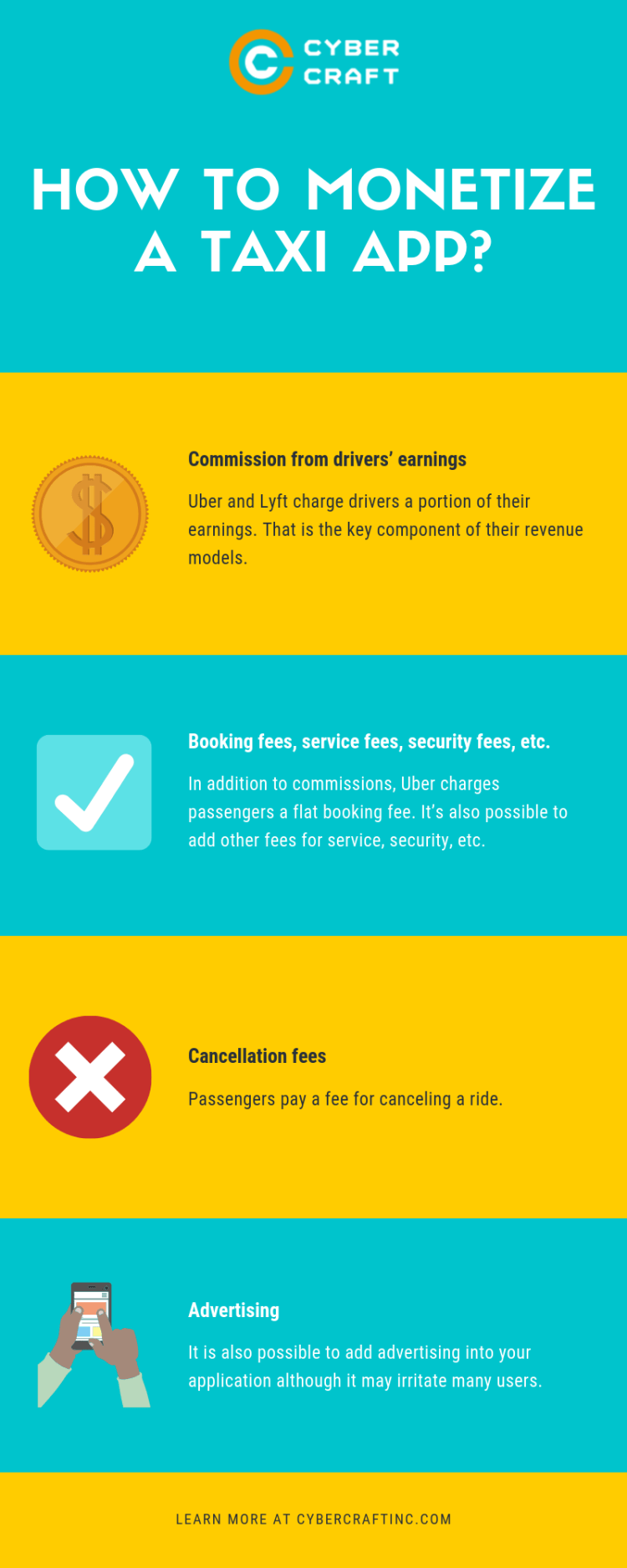
An important aspect of monetization is the earnings commission which you charge drivers. You want to be sure that drivers are happy with it and you offer better terms than your competitors. That will affect how successfully you manage to find and recruit drivers for your app.
Cost to Build an App Like Uber - Uber App Development Cost
Before we provide our calculations of the approximate cost to develop Uber app, we must emphasize that these numbers are approximate and may vary depending on your technical specification and requirements for your future application.
There are two approaches to calculating the cost to develop an app like Uber: standard outsourcing (number of work hours required * hourly rate) and a monthly cost for a development team. While there is little that can be done to decrease the number of work hours required, there are certain things one can do to minimize the hourly rate.
The key factor which influences the hourly rate is the country where your developers are located. If you’re based in the US, for instance, and you plan to hire local developers, there is no doubt that you will end up paying much more than you would had you hired offshore developers from Eastern Europe. Therefore, whether you hire local developers or remote ones will greatly influence the end cost.
Using the former approach the numbers we arrive at are $50,000 as the minimum cost of building an application like Uber (provided you hire offshore developers). A more realistic number would approach $100,000-$150,000.
Applying the second approach, we first need to understand the required team structure to design an app like Uber.
Taxi App Development Team Structure
The minimal structure of a taxi application development team is the following:
- Team Lead/Project Manager
- 3 Android developers
- 3 iOS developers
- QA Engineer
- 3 Backend developers
- UI, UX Designer
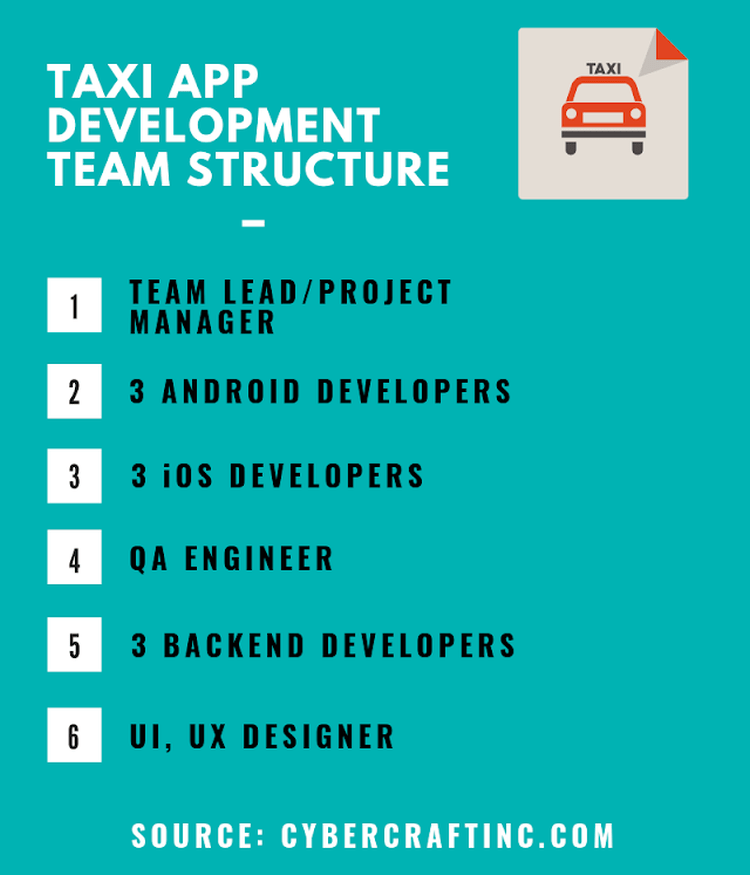
This kind of team would cost at least $40,000-$50,000 a month. That is an ideal option, of course, if you want quick results and an efficient development process. If you want a smaller team, here’s what we would suggest:
- Team Lead/Project Manager
- Android Developer
- iOS Developer
- QA Engineer
- UI, UX Designer
- Backend developer
This team would cost at least $30,000 a month. Bear in mind that the volume of work to be done still remains the same. It will take a longer time for this team to achieve the same result as the first one. In the end, the total costs will be the same or even higher.
The bottom line is, the minimum budget required for building an application like Uber is $50,000 (unless you’re going to hire American developers). The most optimal number seems to be $100,000-$150,000. A decent development team will cost $40,000-$50,000 a month. Finally, bear in mind that these numbers are approximate and may not be accurate in your specific situation. In the end, how much to build an app like Uber costs depends on your specific requirements and other factors.
Having analyzed the minimal cost of building an application like Uber, let’s finally talk about how to get started with your app idea.
How to Develop an App Like Uber: Your First Steps
Building an application like Uber is not a game, it’s a serious process which must be carefully planned and executed. It can be broken down into the following key steps:
- Idea evaluation and market analysis
- Technical specification and requirements
- Selection of the best development model
- Development team organization
Besides development itself, there are many other things to take care of before your developers even begin coding. Diligent analysis and planning are the key and that’s what we’re going to talk about first.
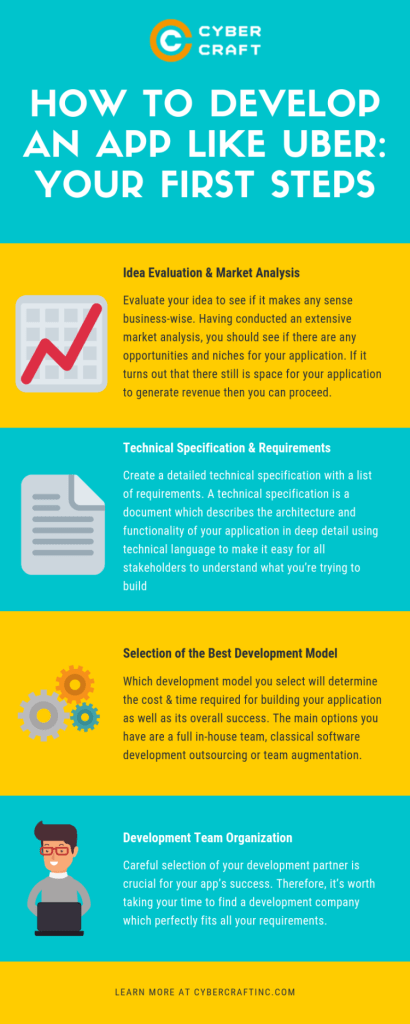
Idea Evaluation and Market Analysis

The first step is to evaluate your Uber application idea to see if it makes any sense business-wise. Having conducted an extensive market analysis, you should see if there are any opportunities and niches for your application. If it turns out that there still is space for your application to generate revenue then you can proceed.
An important nuance that we have to emphasize is your competitive advantage. If you don’t know what your app’s competitive advantage is then don’t even risk building it. You have to clearly define a strong competitive advantage which will increase your chances for success and only then proceed to the next stage.
We’re not going to delve into the details regarding business plans, market analysis, and competitive advantage or business strategy. That would require a separate article. We’ll just emphasize once again that before you even create a technical specification for your taxi application you have to conduct a diligent analysis of all the business aspects related to your idea. In particular, that includes your business plan & strategy, market analysis, and competitive advantage.
Technical Specification & Requirements

The next step is to create a detailed technical specification with a list of requirements. A technical specification is a document which describes the architecture and functionality of your application in deep detail using technical language to make it easy for all stakeholders to understand what you’re trying to build. Basically, it explains what you’re going to build and how it’s going to work. This document is necessary for accurate cost estimation and overall success of the development process.
Selection of the Best Development Model

Which development model you select will determine the cost & time required for building your application as well as its overall success. The main options you have are a full in-house team, classical software development outsourcing or team augmentation.
The first option is the most expensive one, especially if you’re based in the US, UK or Canada. Salaries and other costs related to hiring developers in these countries are some of the highest in the world. Don’t forget about taxes and operational costs such as office space, equipment, etc. For that reason, a full in-house team is not the best option unless you have some really strong reasons to go with it.
As for classical outsourcing, that model implies complete management and development on the outsourcing company’s side. Your only job as a product owner is to provide detailed requirements and specification. Your outsourcing partner will take care of the rest. That model is almost always more cost-effective than in-house development. However, it takes away a large portion of control over the development process and implies certain risks related to offshore outsourcing.
The third model, team augmentation or IT staff augmentation seems to be the best option in many cases. It implies hiring full-time remote employees (usually with the help of a staff augmentation company) who become a part of the development team. The staffing company usually serves as the official employer of these remote employees. A client simply signs an agreement with the staffing company which provides remote dedicated developers to the client.
This model can take two forms: complete augmentation and partial. The former implies the absence of any in-house developers i.e. all positions in a team are remote. This option is also often referred to as a dedicated software development team. Partial augmentation implies that specific positions in a team are going to be remote-based and filled using team augmentation.
Team augmentation helps employers to easily close skills gaps and cut development costs without sacrificing quality. Direct communication and reporting procedures make working with and managing your remote dedicated developers easy and effective.
Having analyzed the best development models to build your own Uber app, the next logical question is…
How to Find the Best Taxi App Development Company?
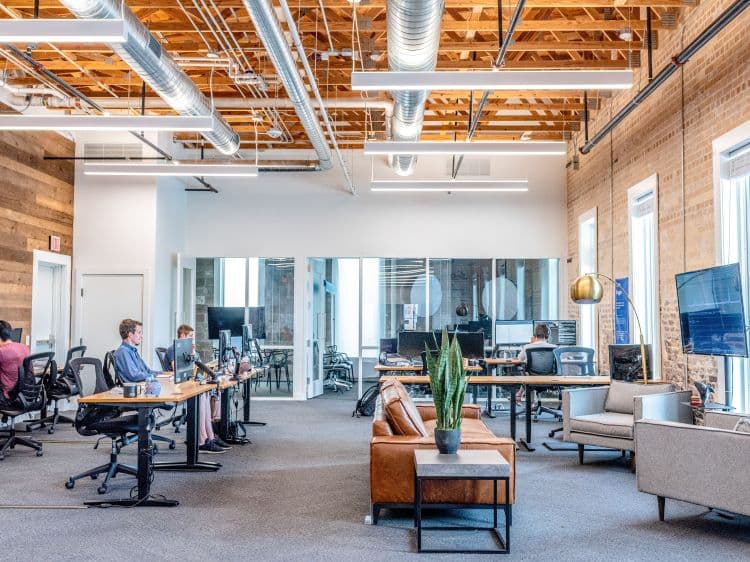
We assume you have already decided if you’re going to work with local developers or hire an offshore software development company. Whatever your decision is, here are the steps you need to take to find the best Uber app developer:
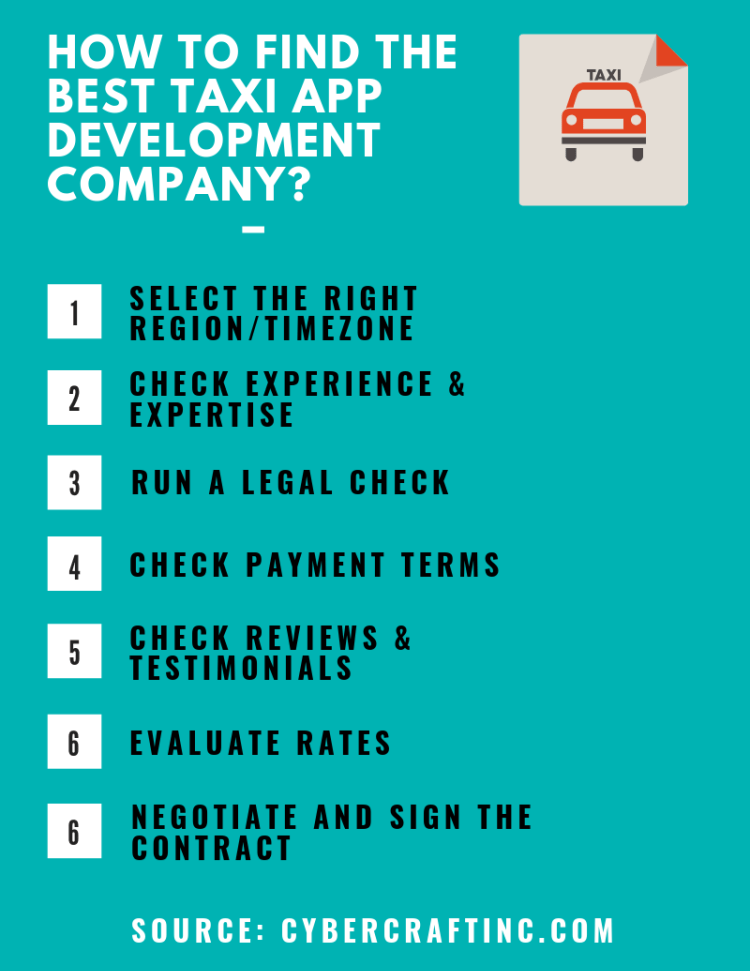
- Location. As we’ve said, the first step is to determine the best location for building your team. At the moment, one of the best regions is Eastern Europe and Ukraine, in particular.
- Expertise & experience match. The next step is to ensure that the company has the right expertise & experience to turn your idea into reality. That especially concerns your tech stack. When we talk about checking experience & expertise, we also mean the developers themselves. You want to be sure that every developer has the right experience and expertise just like the staffing company does.
- Legal check. It’s definitely a good idea to run a legal check on the company. Try to obtain as much valuable information as possible – who the owners and key stakeholders are, history of the corporation, if there have ever been any lawsuits, etc.
- Payment terms. Fair and transparent payment terms are a must. Check to see if there are any hidden costs. Ideally, the staffing company should require a transparent monthly fee for its services.
- Reviews & testimonials. It’s also a good idea to talk to their past and current clients, and also read reviews & testimonials to see if they are accurate.
- Rates evaluation. Ask them to provide rates & salaries with a detailed quote. Carefully analyze the provided figures to see if they are accurate and really worth it.
- Final negotiations & signing of a contract. Finally, having taken all of the above steps, you can proceed to negotiations and sign the contract once you’re happy with the terms.
Careful selection of your development partner is crucial for your app’s success. Therefore, it’s worth taking your time to find a development company which perfectly fits all your requirements.
Conclusion
More and more people in the tech & startup world are wondering how to make a taxi booking app, how to start a business like Uber, and if taxi mobile app development is a sound business idea. If you conduct diligent market analysis and design a strong business strategy, clearly defining your competitive advantage then it may prove a profitable venture.
However, the development process is not that easy. The application’s architecture is quite complex, being broken down into three distinct applications and filled with multiple adapters and APIs. We have described in detailed all the key features for both the driver and passenger apps and explained how Uber itself works and how it generates revenue.
We also mentioned the main monetization strategies for a taxi application and provided approximate estimates for the minimal cost to build such an app, in case you’re asking “how much does an app like Uber cost?” Finally, we also provided the exact steps to take for turning your taxi app idea into a reality.
If you’re ready to get started with building your taxi app, then CyberCraft is your best choice. We’ve been building dedicated development teams and providing team augmentation services for our US clients since 2012. Our clients include prominent Silicon Valley startups and global corporations. Whatever type of taxi application you want to build, we’ve got you covered. Get in touch today – fill out the form below and receive a free quote & consultation for your project.

